2025 Ford Transit: The newest Transit Cargo model consists of two types: the 2025 Ford Transit Passenger Van and the Cargo Van. It has been proven that the Ford Transit is one of the most customizable vehicles on the market. It can be configured according to the payload required, and the overall cargo space can be adjusted to suit the needs of your organization or company.
Updates (June 14, 2025): We’ve updated the 2025 Ford Transit, now offering a smoother driving experience with a 3.5L V6 engine delivering 275 hp and 262 lb-ft of torque. Pricing starts at $49,495 and goes up to $60,295, depending on trim and options.
As far as we know, when reviewing the 2025 Ford Transit in this article, Ford authorities have yet to release official information about the 2025 Transit Cargo. But don’t worry; we will continue to update the information in this post as accurately as possible if there are changes in the future.
However, based on our experience with last year’s Transit Cargo model, we recommend adding features such as a 12-inch infotainment screen, surround-view camera system, and digital mirrors to make maneuvering this large van in tight spaces easier.
The Ford Transit, one of the descendants of the classic Ford Econoline van, expands on the original’s versatility with two wheelbases, three body lengths and roof heights, two engine options, and rear- or all-wheel drive. Both engines are V-6 gasoline engines, one naturally aspirated and one turbocharged; however, the E-Transit offers an electric option for buyers with specific requirements.
Regardless of how you construct it, the Transit offers enough space for equipment, parcels, people, and commodities, making it a popular choice among small business owners and fleet operators. Ford even provides several packages (Builders Prep, Parcel Delivery, Adventure, and more) to assist with ordering. All Transit models include essential driving assistance functions, and the Ford Sync 4 infotainment system has a 12.0-inch screen display.
Ford’s management and telematics systems will appeal to fleet managers since they provide visibility into van location and crucial metrics such as speed, idle time, fuel condition, vehicle diagnostics, and maintenance warnings. The Transit’s primary opponents are the Mercedes-Benz Sprinter and the Ram ProMaster, but the Ford appears to be the more agile, earning a spot in our 2024 Editors’ Choice list.
Not many. 2024 is primarily a transition year for the Transit, though Ford has grouped several choices and accessories into a more unified package to make ordering easier. Furthermore, most models get new automated halogen headlights and a 253-degree wide rear door as standard. A 12-volt power outlet and cruise control are also standard features.

All-New 2025 Ford Transit Review
The 2025 Transit is Ford’s versatile replacement for its long-lived Econoline van series. Introduced in 2015, the Transit Cargo offers seating for up to three people. It is available with various attractive options in roof height, wheelbase length, rear or all-wheel drive choice, and various tow ratings.
The Transit is also available as a passenger van and in an electric version known as the E-Transit. We review the two models separately.
It’s tough to comprehend how many configurations are conceivable with the Transit Cargo van. For starters, there are three roof heights, two wheelbase versions, an extended-length version, optional all-wheel drive, and a wealth of interior options and combinations to meet the needs of each tradesperson. Furthermore, Ford may modify the Transit Cargo (upfitting) to serve as an ambulance, RV, or even an overlander known as the Transit Trail.
We believe the 2025 Ford Transit model is also being positioned as a spiritual successor to the classic Ford Econoline van, capitalizing on the original’s overall versatility with two wheelbases, three body lengths and roof heights, two engine options, and rear or all-wheel drive. Both engines are V-6 gasoline engines, one naturally aspirated and one turbocharged; however, the E-Transit offers an electric option for buyers with specific requirements.
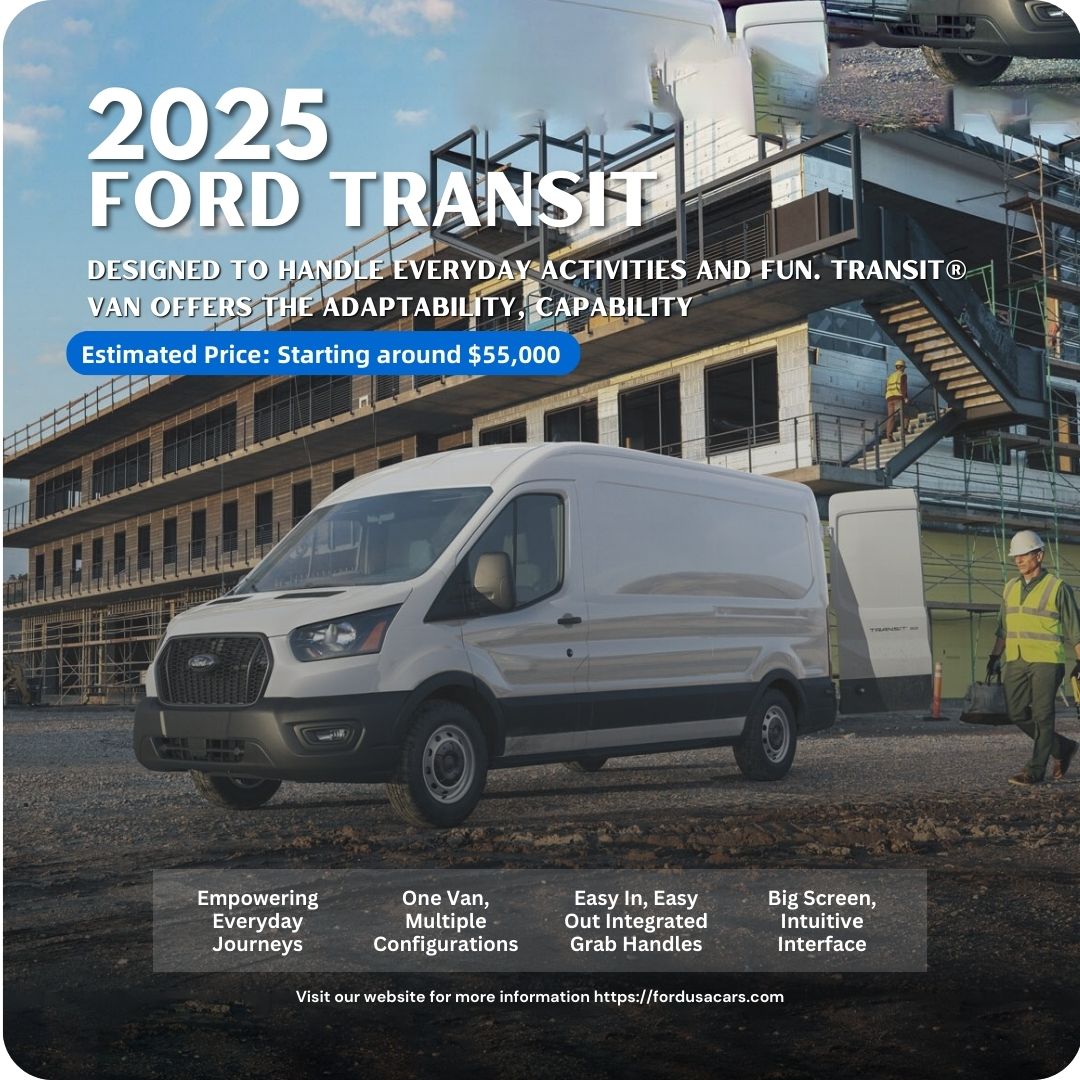
Regardless of how you construct it, the Transit offers enough space for equipment, parcels, people, and commodities, making it a popular choice among small business owners and fleet operators.
Ford even provides numerous packages (Builders Prep, Parcel Delivery, Adventure, and others) to assist with ordering. All Transit models come standard with essential driving aid functions, and the Ford Sync 4 infotainment system features an enormous 12.0-inch display screen.
Ford’s management and telematics systems will appeal to fleet managers since they provide visibility into van location and crucial metrics such as speed, idle time, fuel condition, vehicle diagnostics, and maintenance warnings. The Transit’s primary opponents are the Mercedes-Benz Sprinter and the Ram ProMaster, but the Ford appears to be the more agile, earning a spot in our 2024 Editors’ Choice list.
2024 is primarily a transition year for the Transit, though Ford has grouped several choices and accessories into a more unified package to make ordering easier. Furthermore, most models get new automated halogen headlights and a 253-degree wide rear door as standard. A 12-volt power outlet and cruise control are also standard features.
- No significant changes are predicted.
- Part of the first Transit generation, which debuted in 2015.
Updates: 2025 Ford E-Transit
Ford’s 2025 E-Transit will be geared toward vocational education. For the latest iteration of its electric van, Ford has opened the order books with four new factory-installed trade packages designed specifically for specific jobs.
Ford also announced pricing for the 2025 lineup and new equipment options; the most important news is that the E-Transit is now priced in line with its gas-powered vans.
As before, the cutaway and chassis cab variants are aimed at business users. The base Cutaway currently starts at $47,795, up $260 from last year. Starting at $48,295, the chassis cab model is $295 cheaper than its predecessor.
Finally, the new base cargo model comes in at $53,095, $290 more than before. Ford is also adding a new $2,000 commercial rebate to help offset the cost of charging for commercial customers if the slightly revised pricing isn’t enough of an incentive.
Back to the new trade packages, Ranger Design can now order the E-Transit cargo van and its gas-powered counterpart as is or with one of four factory-installed packages using upfit components.
The packages are intended to speed financing for commercial customers looking to upgrade their trucks and cut the time from order to delivery.
Among the packages available are an HVAC package with larger shelves and refrigerant storage; a General Contractor package with multi-purpose shelves, drawers, and hooks; an Electrician package that adds drawers and bins for storing spare parts and a reel for hanging cables; and a Folding Shelving package with a large folding shelf intended for shipping.
The General Contractor package is the least expensive at $2,900. The Folding Shelving package is $3,300, the Electrician package is $4,370, and the HVAC kit is $4,400.
- The 2025 Ford E-Transit, which is now being ordered, matches the gas-powered Transit, although some models are slightly more expensive than the previous version.
- With prices starting at $53,095, Ford is offering a new $2,000 incentive to help business customers with charging costs.
- Four factory-installed trade packages designed specifically for specific jobs are now available for Ford cargo vans.
- Starting at $47,795, the 2025 Ford E-Transit is the same as the Gas-Fed Transit.
2025 Ford Transit Changes
Ford has launched four trade-specific upfit packages that you can get right from the factory on cargo vans. The Electrician Trade package comprises drawers and bins to keep parts in order, as well as reels to hang cable. The HVAC Trade package has bins and shelves, as well as racks and restraints for refrigerant containers.
A General Contractor package features some of the same things as the other two packs, while a Foldable Shelving box is made for delivery firms. Smart Acceleration Truncation is a new option for fleet operators of cargo vans. It is designed to take the weight into consideration and stop jackrabbit starts, so your plumber will no longer be able to race for pink slips. The Transit Trail is no longer on the list.
Ford Transit 2025
Ford has updated its full-size Transit lineup with more technology, a new transmission, and, depending on the model, better towing capability. The updated lineup’s first arrivals will begin late in the third quarter of 2024, and Ford says additional specifications will be released closer to launch.
Technically, Ford isn’t calling the updated range a 2025 model but the MY24.75. Gross combined mass (GCM) and braked towing capacity are available for the following models:
| Models | GCM | Braked towing capacity |
| Transit 350L LWB FWD van | 6000kg (+1750kg) | 2750kg (+950kg) |
| Transit 350L LWB RWD van | 7000kg (+900kg) | 3500kg (+750kg) |
| Transit 430E RWD single-cab-chassis | 7000kg (+900kg) | 3500kg (+1100kg) |
| Transit 430E ELWB RWD van | 7000kg (+900kg) | 3500kg (+1100kg) |
Ford also said there was a slight increase in payloads for payload models except the E-Transit, although it has not published figures.
The six-speed automatic in 350L front-wheel-drive models has been changed to an eight-speed automatic, which Ford says delivers greater efficiency and a smoother driving experience. It also switches to the rotary gear selector.
You can no longer get a Transit in Australia with a manual transmission, meaning the base price has risen by $3000 – although the entry-level front-wheel-drive 350L is only $500 more expensive than the previous model.
All models get an 8.0-inch semi-digital instrument cluster, tire pressure monitoring, keyless start, and an embedded 5G modem with FordPass connectivity. In contrast, all but the dual-rear-wheel 430E models get an electronic parking brake.
All but the single-cab chassis get a surround-view camera, although cab-chassis models get front fog lights and front parking sensors in addition to the standard reversing camera.
The Transit’s visual changes are minimal. They include new black badging and a “simplified” Blue Oval design.
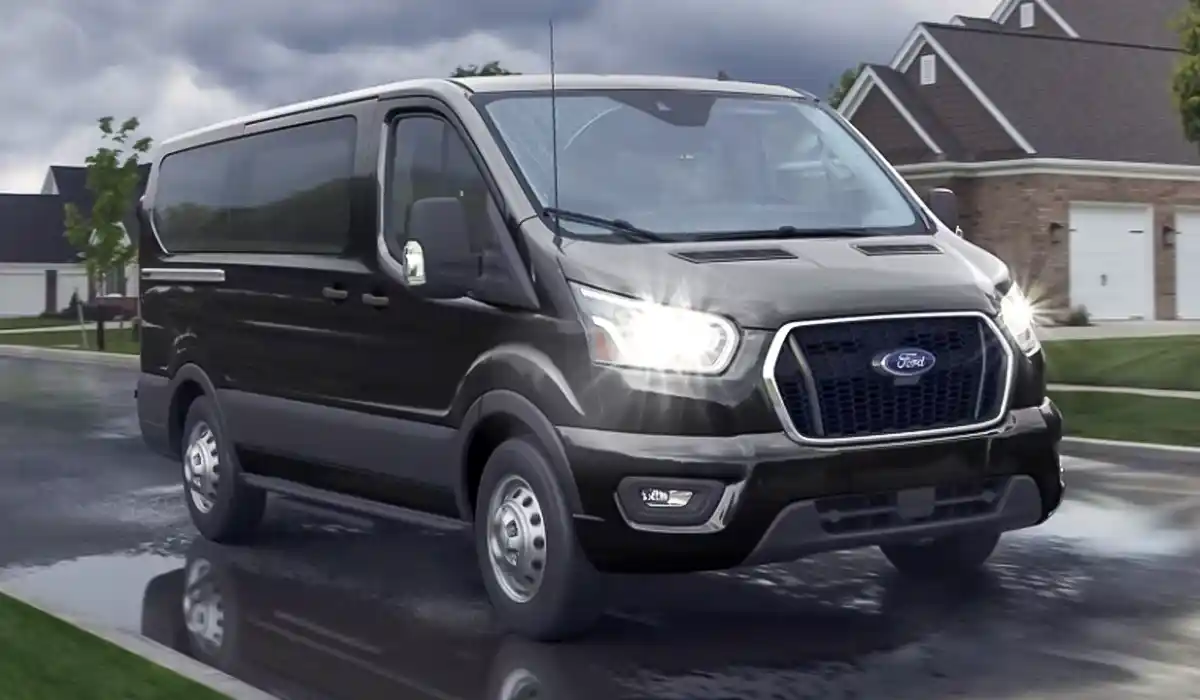
Models
The Ford Transit Cargo Van is a full-size cargo van available in standard and long wheelbase models and low, mid, and high roof body styles. With some limitations, long wheelbase models also offer longer body lengths.
Depending on the configuration, the Transit Cargo Van comes in one trim level in Transit 150, 2025 Ford Transit 250, and Transit 350 versions with increasing gross vehicle weight ratings. Engines include a 3.5-liter V6 (275 horsepower, 262 lb-ft of torque) and an optional 3.5-liter EcoBoost turbocharged V6 (310 hp, 400 lb-ft). A 10-speed automatic transmission and rear-wheel drive are standard, and all-wheel drive is optional.
The Ford Transit Passenger Van is a full-size van available in two body lengths, three roof heights, and single or dual rear wheels. A 3.5-litre V6 (275 horsepower, 260 lb-ft of torque) is standard, and a turbocharged 3.5-litre V6 (310 horsepower, 400 lb-ft of torque) is available.
Both are combined with a 10-speed automatic transmission. Rear-wheel drive is standard, and all-wheel drive is available. Two trim levels are available: XL and XLT. Highlights of each are listed below.
On 2025 Ford Transit Hybrid models, the E-Transit is only available at one base trim level, and the body style and optional features depend on your commercial needs. We highly recommend adding the Pro Power Onboard system if you need to power electronic devices or equipment on the job site.
If you require interior shelving, E-Transit has several options. In addition to commercial needs, consider driver assistance features like the optional surround-view camera system and parking sensors, which will help you control your E-Transit in tight spaces.
READ NEXT: 2025 Ford Maverick: Introducing New Impressive Compact Pickup Truck Review
2025 Ford Transit Cargo Van
2025 Ford Transit Cargo is a 2025 Transit model, a versatile replacement series presented by Ford for the long-standing Econoline van series. Introduced in 2015, this generation of the Transit Cargo is available with a stunning range of roof heights and wheelbase lengths.
The latest model, the 2025 Ford Transit, offers multiple rear-wheel or all-wheel drive options (2025 Ford Transit AWD) and varying tow ratings. The Transit is also available as a passenger van and in an electric version known as the 2025 Ford Transit Hybrid, better known as the E-Transit.
It’s hard to fathom how many configurations are possible with the New Ford Transit 2025 Cargo Van. For starters, there are three roof heights, two wheelbase options, longer-length versions, optional all-wheel drive, and many interior options and configurations to satisfy every tradesperson’s wish list.
In addition, the reliability of the 2025 Ford Transit Cargo can even be prepared or equipped by Ford authorities for needs such as an ambulance, RV, and even an off-road vehicle known as the 2025 Ford Transit Trail.
- Multiple configurations provide plenty of cargo-carrying capabilities
- Powerful and efficient machine
- Nice driving manners for a van
- Impressive optional infotainment system
Standard Transit Cargo Van features include:
| 16-inch steel wheels |
| Sliding passenger-side door |
| 50/50 rear barn doors (180-degree opening for standard wheelbase; 253-degree opening for others) |
| Rain-sensing wipers |
| Cruise control |
| Air conditioning |
| Vinyl seat upholstery and flooring |
| Power windows, locks and mirrors |
| Keyless entry |
| Manual tilt-and-telescoping steering wheel |
| Bluetooth phone and audio connectivity |
| 4-inch audio display |
| Two USB ports |
2025 Ford E-Transit
This is the 2025 Ford E-Transit electric van, which has few technical differences from the previous generation. However, pricing is interesting, as Ford claims the 2025 E-Transit will cost the same as a “comparable” gas-powered Transit model.
The revised (very modest) electric commercial vehicle starts at $51,000. The Cutaway variant starts at a lower $47,700 while the 2025 E-Transit Chassis Cab is priced at $46,200.
However, the pricing is better. Ford also gives a $2,000 discount on EV chargers and associated installation costs. Ford further notes that the electric van is eligible for a $7,500 federal tax credit for commercial vehicles and costs significantly less than gas models, resulting in up to a 48% reduction in planned maintenance.
So, what’s new for 2025? Customers can now equip the E-Transit with one of four factory-installed, ready-to-use trade packages created by outside accessory vendor Ranger Design.
A $4,370 electrician’s kit includes drawers and storage bins to hold components and spools of wiring. A $4,440 HVAC trade kit consists of a large shelf and storage bin, along with a special refrigerant storage rack and retainer.
The General Contractor package costs $2,900 and includes drawers, storage bins, utility shelves, and hooks. Finally, a $3,300 Folding Shelf Package features a large, deep, fold-out shelf for delivery businesses.
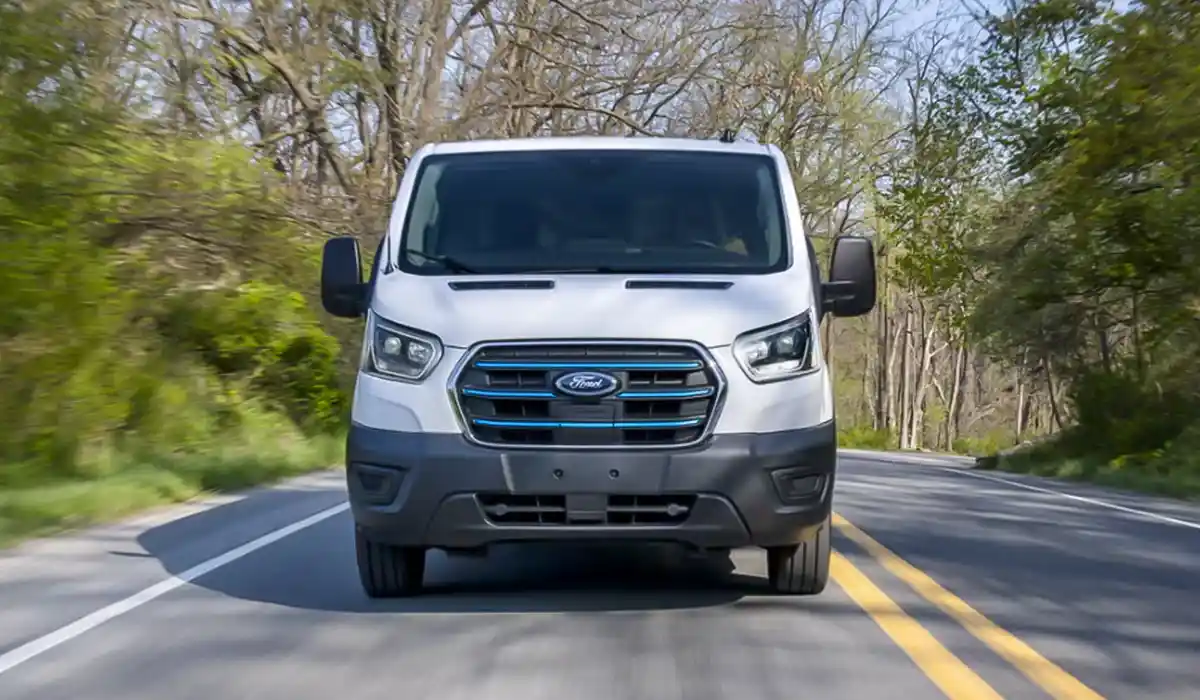
New options include a Wall Liner Kit for conventional or long-body styles, along with a Large Grab Handles Kit for the two D-pillars for easier access in the rear.
While optional, the Mobile Power Cord has a fast-charging adapter for recharging the E-Transit at Tesla Superchargers. Ford is also offering the Smart Acceleration Truncation as a stand-alone item for fleet buyers.
Regardless of driver ability or load, the function automatically calculates the payload for a smooth start every time, limiting the van’s acceleration.
The standard for the 2025 E-Transit is 50/50 rear-hinged doors with a 180-degree opening on all cargo and passenger vans with low and medium roofs.
The standard opening door for all high-roof cargo vans is 253 degrees, while all low—and medium-roof variants can have a specified opening.
Like the upcoming model, the 2025 Ford Transit uses an 89-kilowatt-hour battery that powers a single rear-mounted electric motor that produces 266 horsepower and 317 pound-feet of torque.
On a full charge, the low-roof models have an estimated range of 159 miles; the medium roof reduces the estimate to 148 miles, and the high roof to 143 miles.
On an 80-amp circuit, the battery can be charged from an AC source of up to 19.2 kilowatts for a 0-100% recharge in six hours and 11 minutes. From a suitable parking spot, a low-roof vehicle can achieve 67 miles of range in about 15 minutes; the maximum DC fast-charging rate is 176 kW.
2025 Ford Transit Hybrid (E-Transit)
The 2025 Ford Transit Hybrid E-Transit is an alternative for cars that need towing or for those who need it as a cargo car. Its electric concept is different from that of the gas-fueled Transit model. Of course, this affects the range, which the EPA estimates is not very good and limits this van to be suitable for use only in urban areas.
The 2025 Ford Transit Hybrid has features including large cargo space and options allowing you to charge equipment. Suppose you have a flower shop catering business or make several trips on a typical weekday in an urban environment. In that case, E-Transit is very suitable to support the effectiveness of your business or enterprise.
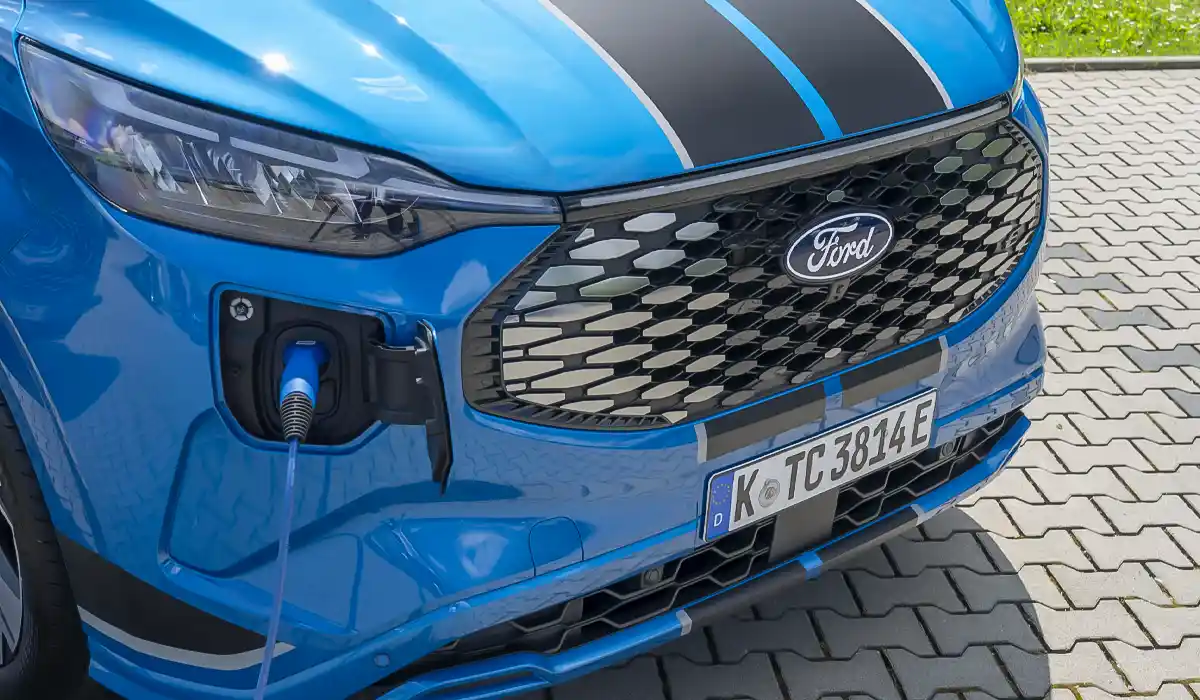
2025 Ford Transit Hybrid/The E-Transit is an all-electric version of Ford’s Transit van designed for commercial use. The van has several roof and length configurations in three styles: Cargo, cutaway, and chassis cab.
The 2025 Ford Transit Hybrid/E-Transit models require less scheduled maintenance than comparable gas-powered vans and emit no exhaust emissions. The van also comes standard with Ford Pro E-Telematics, a fleet monitoring and support system. Ford offers a Pro Power Onboard system that allows operators to power electrical equipment and accessories if job site power is needed.
Thanks to a larger 89-kWh battery pack (up from 68 kWh), the E-Transit’s estimated range increases from 126 to 159 miles for the low-roof model. That may sound like little, but it should be enough for city use with daily charging. Ford has also increased the E-Transit’s maximum fast charging power.
Now, the maximum power is 176 kW, which Ford says is good enough to add 67 miles of range in 15 minutes when connected to a suitable fast-charging station. As for Level 2 charging, the E-Transit can now charge faster, from 0 to 100%, in about six hours using a Ford Pro Series 80-amp charging station. All Ford electric vehicles now have access to Tesla’s massive nationwide charging network.
- Cheaper to operate compared to gas-powered alternatives
- Smart features for commercial users
- Electric power for mobile services
- The larger battery pack provides up to 159 miles of range
- The regular mid-roof and wheelbase configuration has been discontinued
- Part of the first E-Transit generation introduced in 2022
Ford E-Transit
Since its launch, the Ford E-Transit has shown to be a popular entity in the EV van market, holding the top spot for several months. The Blue Oval expects demand for these electrified transports to rise in the coming years.
Therefore, the second-generation E-Transit is already in the works. According to AutoForecast Solutions’ most recent product roadmap, the next-generation Ford E-Transit will begin production in 2026.
According to the revised product roadmap, the next-generation E-Transit will go into production on February 23rd, 2026, and will be built until December 21st, 2035. The new EV van, like all of FoMoCo’s second-generation all-electric cars, will be constructed on a specialized platform, in this case, the same one used for the F-150 Lightning and other full-size trucks, vans, and utility vehicles.
Interestingly, AutoForecast Solutions reports that the next-generation E-Transit will be manufactured at the Ohio Assembly facility rather than the Kansas City Assembly plant, where it is now produced. This could result from the automaker’s recent multibillion-dollar investment in its Midwest operations.
It would create 6,200 new manufacturing jobs in the United States, convert 3,000 temporary positions to permanent ones, and generate around 74,000 additional indirect jobs.
In addition to this information about the next-generation Ford E-Transit, AutoForecast Solutions previously revealed that the second-generation Ford F-150 Lightning will arrive in 2025, the Ford Ranger EV in 2029, and the all-electric Ford Bronco in 2029. These vehicles aim to continue the automaker’s EV push, which includes a massive $50 billion investment over the next few years.
2025 Ford Transit Passenger Van
The 2025 Ford Transit Van is also a family of full-size 2025 Ford Transit Passenger Vans that are present and sold in the automotive market today. This van can be configured for anything, whether as an airport shuttle or a home for a rock band on tour.
With its advantages, the 2025 Ford Transit is very flexible and can make ordering a little confusing. But this is normal. With only two base trim levels and a decent range of options, the 2025 Transit makes it easy to suit any need.
The Transit Passenger Van is a hybrid of a private and commercial van. It is small enough that anyone with a driver’s license can operate it but large enough to transport large groups. At its widest length, just under 20 feet, the Transit can accommodate 15 passengers in five rows.
The 2025 Transit can also handle payloads of up to 3,000 pounds or tow up to 4,500 pounds. The Transit’s minimalist cabin reflects its workhorse roots, although the XLT trim offers civilized touches like floor mats and sophisticated dash technology. Transit’s flexibility makes it an attractive choice, whether your priorities are people, things, or a sliding scale of both.
- Available in several configurations
- Strong acceleration from the turbocharged V6 engine
- The ride quality is enjoyable for a van
- The infotainment system is easy to use
Ford Transit Passenger Van XL
| 12-passenger (standard length) or 15-passenger (extended length) seating |
| 16-inch steel wheels |
| Sliding passenger-side door |
| Vinyl flooring |
| Cloth seats |
| Front and rear air conditioning |
| Connected services including Ford Telematics for fleet operations |
| Five USB ports |
| Eight stereo speakers |
| Crosswind stabilization assist |
| Forward collision mitigation (warns you of an impending collision and applies the brakes in certain scenarios) |
| Lane departure mitigation (warns you of a lane departure when a turn signal isn't used and can automatically steer to maintain lane position) |
| Driver attention warning (issues an alert if sensors determine you are becoming fatigued) |
| Automatic high-beam headlights |
Ford Transit Passenger Van XLT
| Body-color front bumper |
| Foglights |
| Power-folding, heated exterior mirrors with integrated turn signals |
| Full-length carpeting |
| Reclining rear seats (except for the back row) |
| Sync 4 infotainment system with 12-inch touchscreen |
| Subscription-based navigation |
| Blind-spot warning with rear cross-traffic warning and trailer coverage (alerts you if a vehicle is in your blind spot during a lane change or while in reverse) |
| Front and rear parking sensors (alert you to obstacles that may not be visible in front of or behind the vehicle when parking) |
| Front and rear cameras |
2025 Ford Transit Interior
The Transit has an interior design that is similar to other Ford products. It has a lot of design elements from the Ford Explorer, but it also has certain van-specific features, like big cupholders at each end of the dashboard. For a work van, the seats are comfy, the ride is smooth, and the noise level inside is kept to a minimum. You may customize it to match your needs because the roof heights and wheelbase lengths are all different. The Crew Van has a second row of seats that can hold three more people, and there is still plenty of room for freight or gear. The passenger wagon can hold up to 15 people. The Transit Trail is a camper-ready variant that has features inside that make it a good adventure van, like front seats that swivel, an AC inverter, and a fuse panel. You won’t find a living area in the Transit Trail that looks good on Instagram; Ford leaves that kind of customisation up to you or the upfitter of your choice.
In the outback, getting in and out of a large van like the Transit will always be difficult, but the wide-opening front and side doors make it easier. Once you’re inside, the driver’s controls are well laid out, with large knobs for climate control and intuitive buttons on the dash and steering wheel.
The driving position is a low point for the Transit, offering a sort of top-down view of the dashboard, with a long reach to the steering wheel for taller drivers. Forward visibility is excellent, but a large pillar behind the driver obscures direct side views.
The blind spot warning system is helpful here. A high-mounted wide-angle rearview camera and large side mirrors also help get this big van into relatively tight spaces.
We will find the 2025 Ford Transit Hybrid Interior with a center-mounted infotainment screen, easy-to-read gauge cluster, and steering wheel. That’s it, and for a van that’s focused on work and not play, we think that’s more than enough. The driving position is a little too high, and the pedals feel awkward, but that’s the E-Transit’s biggest fault in this area.
The rest of the cargo van is also full of helpful features. The LED lights in the cargo area are very bright, and the rear doors are open with a small latch system.
There are also tie-downs to secure cargo, a strong floor that looks and feels like it will withstand a lot of wear and tear, and side doors for easy curbside loading. Thanks to the tall, upright windshield and large side mirrors, visibility isn’t as bad as you might think for a panel van.
The Transit’s cabin design is reminiscent of the current Ford vehicle lineup, incorporating several design influences from the Ford Explorer and van-specific characteristics such as prominent cupholders at each end of the dashboard. The seats are comfy, the ride is smooth, and the work van’s internal noise levels are low.
Various roof heights and wheelbase lengths create a virtual blank slate that may be customized to meet your requirements. The Crew Van adds a second row of seating to accommodate three more passengers while providing plenty of room for freight or gear and some modest comforts; the passenger wagon can seat up to 15.
A camper-ready variant called the Transit Trail is also available. It has a more robust appearance and interior features befitting an adventure van, such as swivelling front seats, an onboard AC inverter, and a built-in fuse panel. The Transit Trail does not include an Instagram-worthy living space; Ford leaves that customization to you or your preferred upfitter.
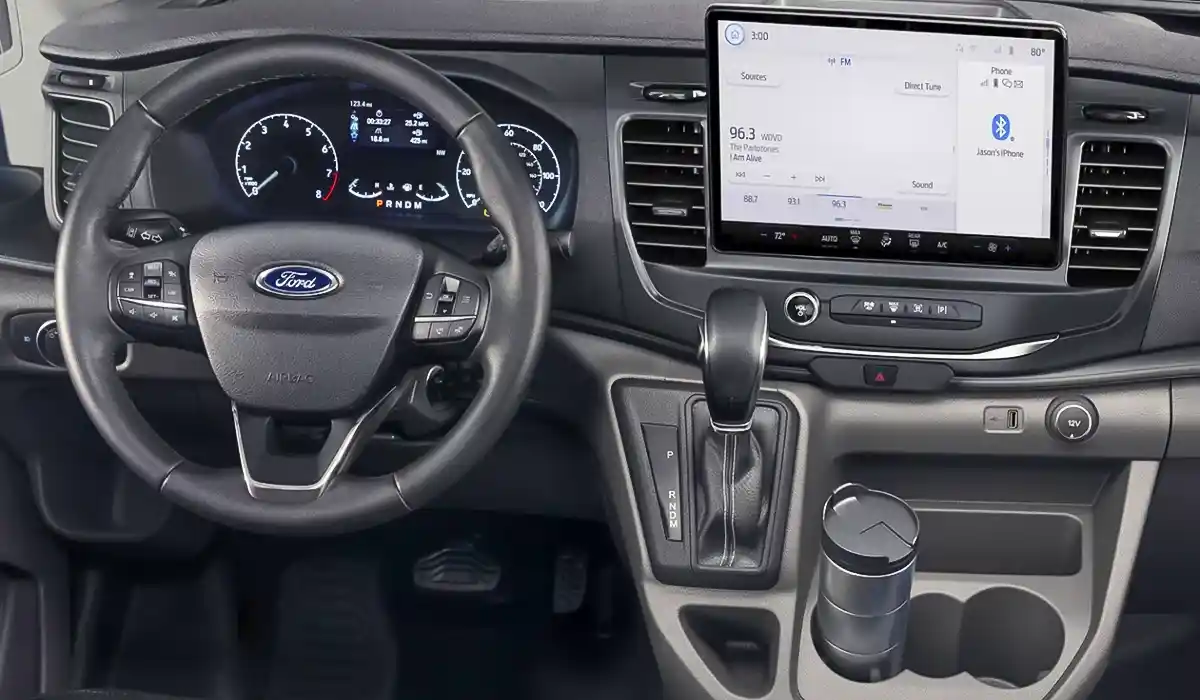
Entertainment and Connectivity
The base Transit has a four-speaker sound system, Bluetooth for phone calls and music streaming, and a 4.0-inch display that can do many things. All models come with a Wi-Fi hotspot that makes it easy for your passengers to connect to the internet. You can get a bigger 12.0-inch display screen that runs Ford’s Sync 4 software. The new system has built-in navigation, Sirius XM satellite radio, and the ability to connect an Android or Apple smartphone to the car.
The base Transit includes a four-speaker sound system, Bluetooth phone and audio streaming, and a 4.0-inch multi-function display. All versions include a Wi-Fi hotspot, allowing your passengers to connect easily.
The choices include a larger 12.0-inch display panel with Ford’s latest Sync 4 software. The improved system includes integrated navigation, Sirius XM satellite radio, and Android Auto/Apple CarPlay smartphone compatibility.
Comfort
The 2025 Ford Transit offers an excellent ride, even in its rugged 14-passenger configuration. Most large shocks can be absorbed, and only the harshest impacts penetrate the cabin.
Road and wind noise are quite noticeable due to the large profile, but that’s to be expected. Still, it’s not as loud as some of its competitors.
The 2025 Ford Transit has a comfortable, albeit oddly positioned, driver’s seat, that provides support and comfort on long journeys. The rear seats are a little flatter and less comfortable, but they are quite acceptable for a heavy-duty van.
The climate control system keeps the spacious cabin cool on hot days, and the optional heated front seats provide good warmth on cold days.
The 2025 Ford Transit Hybrid/E-Transit is quite comfortable for daily commuting. The ride tends to be firmer, even when not carrying a load, and as a result, the E-Transit can sometimes ride over bumps and expansion joints. The seats aren’t particularly supportive, but they offer adequate adjustability and can lie almost flat if you want to nap while the van is charging.
However, the seats and ride are only some of the drawbacks of E-Transit in terms of comfort. Simply put, the inside is noisy. Although the EV powertrain is quiet, there is no sound-dampening material, and wind noise is noticeable inside.
Additionally, the van’s rear metal panel is thin and wobbles against the back of the E-Transit’s frame, causing an absolute frenzy when driving on city streets. Earplugs might not be a bad idea.
Tech
2025 Ford Transit comes with Ford’s optional Sync infotainment system, a must-have on the Transit. The system has a clear 8-inch navigation display, easy-to-use voice control, and smartphone integration for Apple and Android devices.
The eight-speaker stereo system with the Sync system could be more impressive, but it works well. Six USB ports and two 12-volt outlets can also charge most devices.
Several driver-aids are available on Transit. Blind-spot warning and rear cross-traffic alert systems are available as standard features. Adaptive cruise control and a split-view front camera are optional. Both worked well during our testing.
While comfort isn’t this van’s top priority, some handy technology is here. The audio system is adequate, and Ford’s new Sync infotainment system is easy to use.
The 2025 Ford Transit Hybrid’s system features wired or wireless Apple CarPlay and Android Auto that worked flawlessly during our time with the car. The screen is also quick to respond and turns on quickly.
While the E-Transit’s list of driver aids isn’t as eye-catching as a regular car, having options for nifty features like blind-spot warning and adaptive cruise control on a panel van is helpful. These features take a lot of the stress out of the daily routine these vans often face and will likely be appreciated by E-Transit drivers.
Cargo
The 2025 Ford Transit storage area is one of the large dimensions with a high roof and long wheelbase, allowing plenty of storage space. Under the seats, there is plenty of space for luggage, and small items can be stored in several front compartments.
Large, deep, plentiful glass holders fill the cabin for everyone who enters the 14-person fast-food restaurant late at night. A total of 11 car seats can be loaded, although attaching them to the lower straps may take a little time.
The 2025 Ford Transit Hybrid with four storage highlights this cargo van. Our test van had a low-roof configuration and standard length. Frankly, that feels like a big enough space to live in for a long time, and with the option to add Pro Power Onboard (an option that turns the E-Transit into a powerhouse), we wouldn’t be surprised if the E-Transit was soon considered as the next big thing in the #vanlife movement.
Another strong point is its maximum carrying capacity rating. In our configuration, the E-Transit could tow up to 3,880 pounds, which is on par with most gas-powered Transits’ range. However, driving with maximum load will negatively impact the E-Transit’s limited range.
READ NEXT: 2025 Ford Ranger: Ultimate Adventure Mid-size Pickup Truck Review
2025 Ford Transit Engine
You may get the Transit with either rear or all-wheel drive and two different powertrains. The 3.5-liter V-6 engine with no turbocharger has 275 horsepower and 262 pound-feet of torque. The EcoBoost turbocharged 3.5-liter V-6 has a power rating of 310 horsepower and 400 pound-feet of torque. Both of them work with a 10-speed automatic transmission. We enjoy how the suspension tune makes it easy to drive like a van and also gives it good handling. These don’t make or break the deal for a van, but they do help keep the people inside feeling fresh on extended trips.
The previous Transit we tested went from 0 to 60 mph in 6.7 seconds. That’s a fast acceleration for a full-size van.
The 2024 Ford Transit has two powertrain options: rear or all-wheel drive. The naturally aspirated 3.5-litre V-6 produces 275 hp and 262 lb-ft of torque, while the EcoBoost turbocharged 3.5-litre V-6 generates 310 horsepower and 400 pound-feet of torque.
Both are paired with a 10-speed automatic gearbox. The turbo V-6 variant has a reputation as an unusual speed merchant. The last Transit we tested reached 60 mph in 6.7 seconds and completed the quarter mile in 15.3 seconds. This is outstanding acceleration for a full-size van.
We also appreciate its compliant-for-a-van suspension setting, which delivers adequate handling to match its speed. While these do not make or break a van’s deal, they do go a long way toward keeping the occupants refreshed on prolonged trips.
2025 Ford Transit Hybrid/The E-Transit is easy to drive. Its acceleration figures are not particularly high, but its 0-60 mph run of 8.4 seconds is quite quick for a vehicle of this type. The more important figure is the E-Transit’s 0 to 30 mph sprint of 3.7 seconds, perfect for city driving.
Braking is also like a van, taking 140 feet to stop from 60 mph. For context, heavy-duty pickup trucks often stop within the same distance. Load the van with cargo, and braking will only take longer. Unlike some other EVs, there’s no one-pedal driving.
The E-Transit isn’t built to be a handling star, but thanks to its fully electric powertrain, it’s easy to drive and use daily. Smooth power delivery from the line and relaxed throttle response make it easy to accelerate and stop in a controlled manner.
How it works The Transit Passenger Van is equipped with a 3.5-liter turbocharged V6 engine, which gives the Transit a lot of character. Thanks to the 10-speed automatic transmission, acceleration is easy and smooth around town, and when you need to climb a mountain or cruise away from a light, the EcoBoost engine has you covered.
The 2025 Ford Transit can accelerate from 0 to 60 mph in 8.7 seconds, which is downright jolting for a big and heavy vehicle.
Normal braking feels easy and responsive, but the 2025 Transit takes a little longer to panic brake under emergency braking conditions than other vans.
The Transit’s steering gives you a decent feel for the road and easily returns to the center after turning. The handling is surprising because this giant van is quite fun to drive, even if you haven’t converted it into a party bus.
2025 Ford Transit Powertrain
The 2025 Ford Transit is powered by a 2.0-litre four-cylinder turbodiesel engine that produces 121kW of power and 390Nm of torque.
The front-wheel-drive 350L uses a new eight-speed automatic transmission, while the rear-wheel-drive model uses a 10-speed automatic.
The E-Transit has a single-motor electric powertrain with 198kW and 430Nm.
Efficient
No fuel consumption figures are available for the Ford Transit range.
The E-Transit has a 68kWh (usable) battery with a WLTP range of 230 and 307km with the regular roof and 222kg and 295kg with the optional high roof.
It has an 11.3kW onboard AC charger and 115kW DC fast charging capability.
2025 Ford Transit Payload
The 2025 Ford Transit can handle up to 3,000 pounds of payload or tow up to 4,500 pounds.
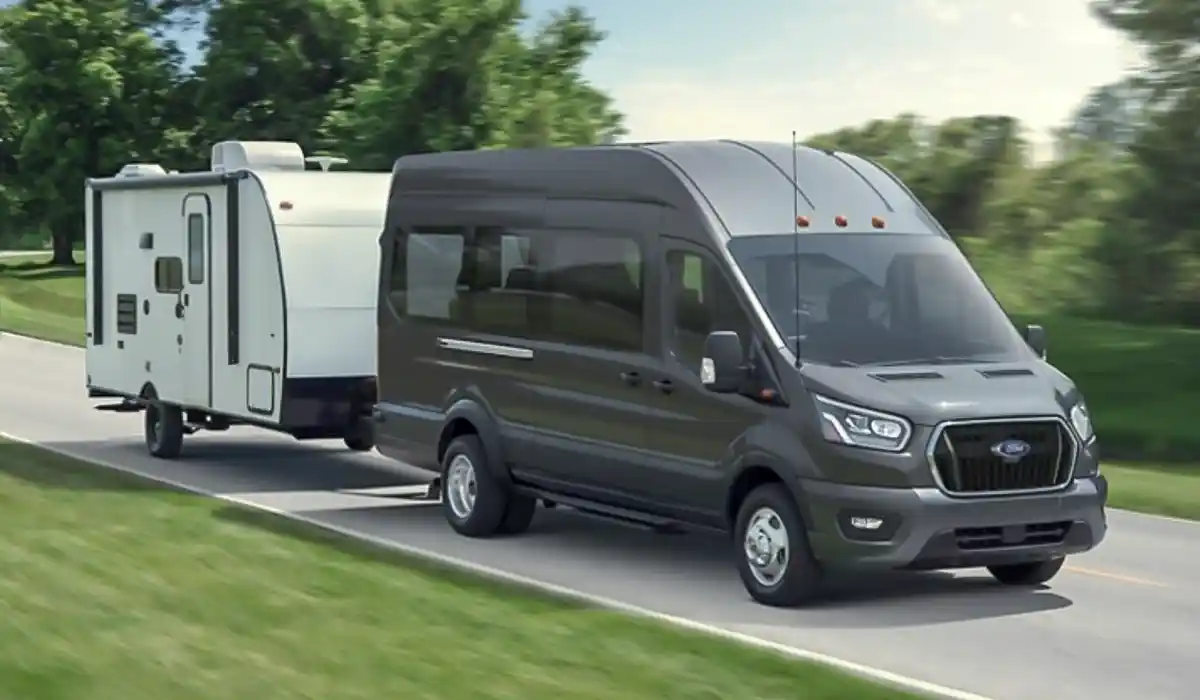
2025 Ford Transit MPG
The Transit and other full-size vans don’t have to follow government fuel-economy rules, so there are no EPA ratings to look at. These huge boxes are not very aerodynamic and are usually hefty, which is not good for fuel economy. We only got 13 mpg out of a 2020 Transit 350 High-Roof 4×4 with a turbocharged V-6, but it did get 16 mpg in our 75-mph highway fuel-economy test. In our freeway test, an identical model with the same engine and rear-wheel drive did a little better, at 17 mpg.
Full-size vans like the Transit are exempt from federal fuel efficiency rules. As a result, this van has not been tested by the EPA. Full-size vans are naturally aerodynamically challenging and tend to be overweight, resulting in less-than-ideal fuel efficiency numbers.
A 2020 Transit 350 High-Roof 4×4 with the turbocharged V-6 we tested yielded only 13 mpg overall, but it did manage 16 mpg on our 75-mph highway fuel economy route. An identical rear-wheel-drive vehicle with a turbocharged V-6 achieved 17 mpg on the interstate.
The 2025 Ford Transit Hybrid has an EPA range of up to 159 miles on a single charge. While that’s too short a distance for us to run a real-world mileage test, we found over two weeks that the E-Transit is slightly more efficient than the numbers suggest.
Indeed, we drove it with almost no load and in Eco mode for most of our use. Ford says the E-Transit can be charged at a maximum of 176 kW.
With adequate fuel economy, the 2025 Ford Transit performs with a 3.5-liter turbocharged V6 engine. Due to its heavy-duty status, the Transit isn’t rated for fuel economy by the EPA, but during our testing, it couldn’t top 13 mpg even on a long stretch of highway.
2025 Ford Transit Competitors
The Ram ProMaster and Mercedes-Benz Sprinter are similarly modern and versatile options to the Ford Transit. Buyers seeking a more classic and significantly older style can consider the Chevrolet Express. If a Ford Transit is too large for your needs, Ford now provides the Transit Connect, which is smaller.
The Ford E-Transit van has few competitors. The new Mercedes-Benz eSprinter van costs much more than the E-Transit but has a longer range. Electric vehicle startup Rivian recently started selling Rivian Commercial Vans to fleet customers. Ram also plans to make an electric version of its ProMaster commercial van. For a comprehensive review of E-Transit, check out our Edmunds Expert Ratings below.
2025 Ford Transit Colors
Frozen White is the standard paint color across the range. Prestige paint is a $700 option, with the following finishes available:
- Silver Transformation
- Magnetic Grey
- Metallic Black Agate (van only)
You can also choose Special Order Paint, which costs $1400.
2025 Ford Transit Dimension
The Ford Transit measures 5981mm long in 350L van form, 6704mm as an ELWB van, and 6579mm as a single cab chassis.
The height also varies depending on the model. The 350L van measures 2541–2543mm high with the regular roof, 2780–2782mm high with the high roof, 2790mm high as an ELWB van, and 2205mm high as a cab chassis.
The Ford E-Transit is 6035mm long, 2573mm or 2683mm high, and has a wheelbase of 3760mm.
All Transit models are between 2110mm and 2112mm wide.
| Models | Gross Vehicle Mass (GVM) | Gross Combined Mass (GCM) | Braked towing capacity |
| 350L LWB FWD van | 3550kg | 6000kg | 2750kg |
| 350L LWB RWD van | 3550kg | 7000kg | 3500kg |
| 30E ELWB RWD van | 4300kg | 7000kg | 3500kg |
| 420L LWB E-Transit van | 4250kg | n/a | n/a |
| 430E RWD single-cab-chassis | 4300kg | 7000kg | 3500kg |
| 410L RWD bus | 4100kg | 7000kg | 3500kg |
2025 Ford Transit Safety
The Ford Transit includes several basic driver-assistance features that can help to avoid accidents. For additional information on the Transit’s crash test results, see the National Highway Traffic Safety Administration (NHTSA) and Insurance Institute for Highway Safety (IIHS) websites. The critical safety elements are:
- Standard forward collision warning with automatic emergency braking.
- Standard lane-keeping assistance and lane departure warning
- Available adaptive cruise control.
2025 Ford Transit Security
The Ford Transit has not been crash-tested by ANCAP or Euro NCAP.
Ford hasn’t released a complete equipment list for the updated Transit range, but the current model comes standard with the following:
- Front, front side, and front curtain airbags
- Autonomous emergency braking
- Pedestrian detection
- Crossroads assistance
- Adaptive cruise control
- Lane-keeping assistance
- Reversing camera
Van and bus models also get:
- Blind-spot monitoring
- Rear cross-traffic alert
- Front and rear parking sensors
Ford has confirmed that the cab chassis has front parking sensors for MY24.75, while all other models have surround-view cameras.
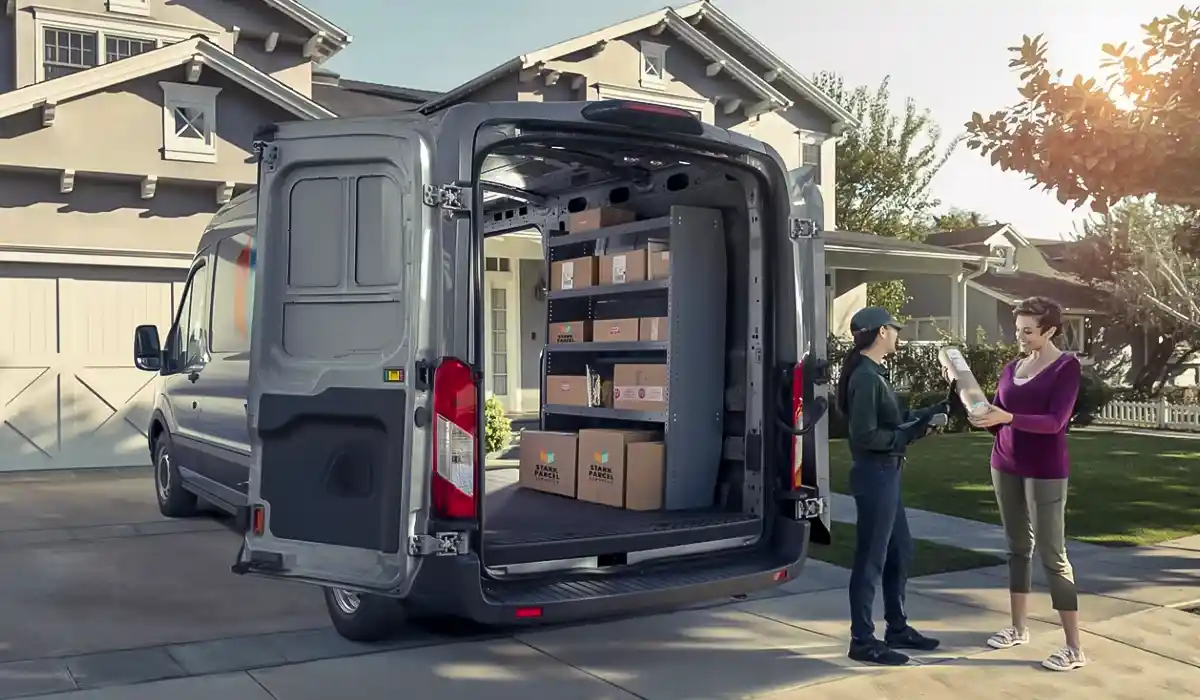
2025 Ford Transit Standard Equipment
Standard equipment on the Transit includes:
- 8.0-inch semi-digital instrument cluster (NEW)
- Tyre pressure monitoring ( NEW )
- Keyless start (NEW)
- 12-inch touchscreen infotainment system
- Satellite navigation
- Apple CarPlay and Android Auto
- Radio digital DAB+
- Four-speaker sound system
- The steering wheel is covered in faux leather
- Automatic headlights
- Automatic high beam
- Rain sensing wipers
- Upholstery
- Heated front seats
2025 Ford Transit Competitor
The Transit’s competitors are an eclectic group that includes Chevrolet, GMC, Ram, and Mercedes-Benz. The Chevrolet Express and its twin GMC Savana were the last truck-based vans popular in the US for decades. They could tow a lot but were powered by power-hungry V8 engines, offered fewer configurations, and hadn’t seen any significant changes in decades.
More relevant competitors are the Ram ProMaster and Mercedes-Benz Sprinter. Like the Transit, the Sprinter comes in various roof lengths and heights and offers an efficient diesel engine option.
The Ram ProMaster and Mercedes-Benz Sprinter offer options that are as modern and versatile as the Ford Transit. Buyers looking for a more traditional, much older design should consider the Chevrolet Express. If the Ford Transit is too big for your needs, Ford offers the smaller 2025 Ford Transit Connect.
READ NEXT: 2025 Ford Bronco: All-New Adventure Performance SUV Review
Service and Warranty
The Ford Transit’s range is backed by a five-year, unlimited-kilometre warranty. The E-Transit’s electric drivetrain and battery are covered by an eight-year, 160,000-km warranty.
Service prices for the updated range have yet to be made available.
2025 Ford Transit Price
The 2025 Ford Transit costs between $49,495 and $60,295, depending on the trim and options. We think the base-model Ford Transit T-150 Cargo Van is the best deal of the lot.
The outside of this van has power-adjustable side-view mirrors and split swing-out rear doors that make it easier to get to the cargo. It rides on 16-inch steel wheels.
The driver’s seat can be adjusted in four ways, and the steering column may be tilted and telescoped by hand to assist you get comfortable behind the wheel. Bluetooth connectivity, two USB ports, and air conditioning are among of the usual features. To make lane changes safer, we’d add the optional blind-spot monitoring.
| Models | Price (MSRP) |
| Transit Cargo Van | $49,495 |
| T-250 Cargo Van | $50,495 |
| T-350 Cargo Van | $51,695 |
| T-350 Crew Van | $58,495 |
| XL | $58,495 |
| XLT | $60,295 |
2025 Ford Transit Release Date
We predict the 2025 Ford Transit will arrive in the fall 2024
Verdict
The Ford Transit is one of the most powerful vehicles today. The van is heavy, has a double rear wheel configuration, has a high roof, and can hold 14 passengers. That sounds long, but it means it can hold maximum cargo, transport large groups easily, and tow large trailers.
Under the hood is an impressive 3.5-liter turbocharged V6 engine, and inside is the easy-to-use Sync infotainment system. The drawbacks include poor fuel economy and a less-than-ideal driving position, but the Transit is still a class leader.
The Transit Cargo is one of the most adaptable and customizable trucks available today. While we don’t expect any substantial changes for Ford’s workhorse, we believe it will continue to be a competitive option for van buyers regardless of their needs.
We’ll be back soon with more on the 2025 Ford Transit, so bookmark our website to stay updated with the latest Ford Transitnews, 2025 Transit news, and information on other Ford models.
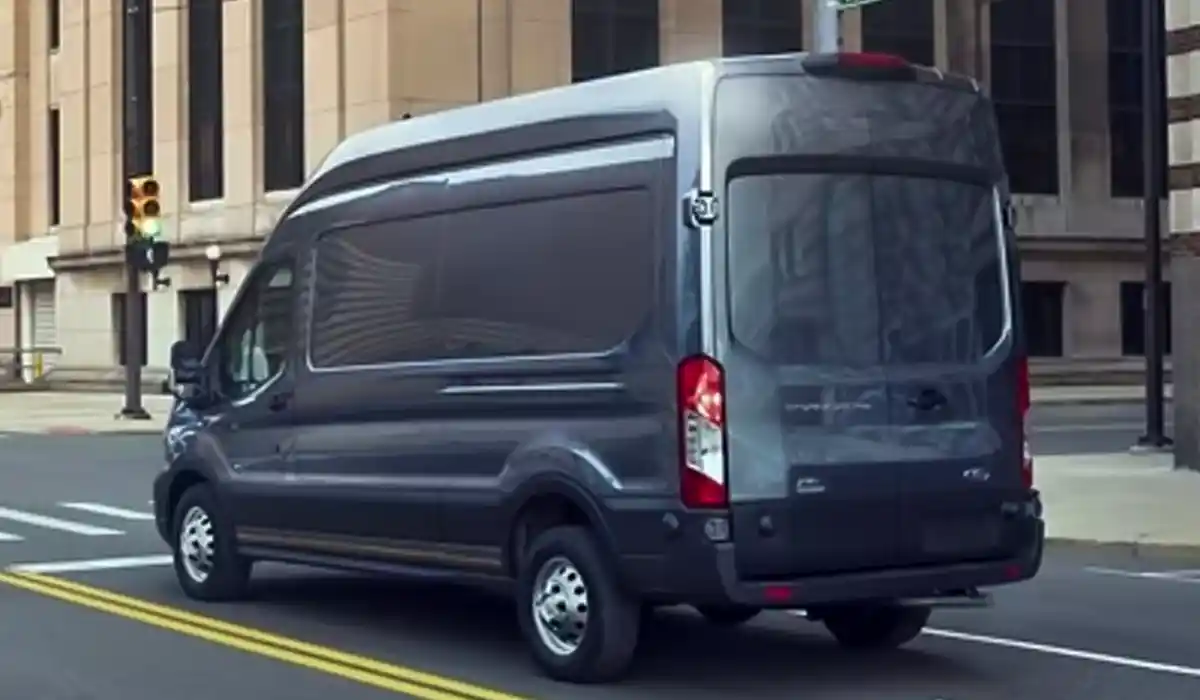
Video Discovery: Ford Transit Trail: It’s A Raptor Van!
FAQs: People also ask about Ford Transit 2025
Q: Will Ford discontinue the Transit van?c
A: Following a drop in compact business sales, Ford will discontinue its small van, the Transit Connect, in 2023. Ford designs a vehicle that is ideally adapted to the daily lives of most Americans. Despite its compact size, it can move as much as a small SUV without being overly tall or aerodynamic.
Q: What size is the Ford Transit Custom 2024?
A: 320S (swb), 2.0L, Diesel, 6-Speed Automatic.





